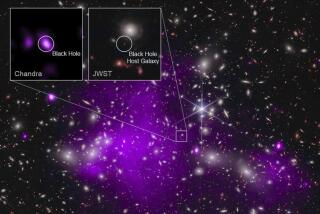Black holes dating to the early universe
- Share via
Astronomers have discovered a hidden collection of supermassive, growing black holes dating back to the early universe -- showing, for the first time, that black holes populated the cosmos far earlier than thought.
The findings, published online Wednesday in the journal Nature, could help scientists understand how these black holes are born, how big they grow and how galaxies develop with them.
“We know the nearest galaxies, like our own Milky Way, all have supermassive black holes in the center,” said lead author Ezequiel Treister, an astronomer at the University of Hawaii. “And the question is, how did they form? How did they get there?”
Astrophysicists had theorized that black holes would be found at the center of galaxies very early in the universe. But when astronomers tried to detect them -- by looking for X-ray radiation emitted by dust falling into a black hole -- they came up empty.
X-rays, unlike visible or infrared light, can escape the powerful gravitational pull of a black hole.
And so Treister decided to look for high energy X-rays using NASA’s space-based Chandra X-ray Observatory. Because earlier searches had failed, the team combined the signals coming from about 200 galaxies that had existed less than 1 billion years after the Big Bang.
The scientists were surprised to find that at least 30%, and possibly many more, of the galaxies contained black holes -- showing that the strong association between black holes and galaxies dates to the very young universe. Astronomers hadn’t been able to detect these black holes before because they were surrounded by clouds of gas and dust that obscured all but the most high-energy radiation from view.
“This paper takes that relationship [between black holes and galaxies] back to when the universe was only a billion years old -- quite further back than we’ve been able to take it before,” said Harvey Tananbaum, director of the Chandra X-ray Center at the Smithsonian Astrophysical Observatory in Cambridge, Mass.
“This is completely new and unexpected -- no one expected this connection to start so early in the universe,” Treister said.
Scientists are still not sure how these ancient black holes were formed. One theory is that several smaller black holes eventually merged together. Another suggests that individual black holes sucked in huge amounts of gas and dust and grew to supermassive size.
The reason why black holes and galaxies are connected also remains a mystery, said Mitchell Begelman, an astrophysicist at the University of Colorado who was not involved in the study. Does galaxy formation depend on black holes, or do black holes need galaxies to form? It’s probably both, Begelman said.
“We’re pretty sure there’s a connection there -- we just don’t understand exactly what the relationship is,” he said. By studying these early black holes and their galaxies, he added, “we’re hoping eventually to understand how this interplay works.”
--







